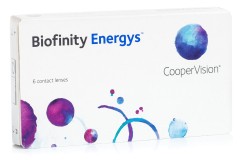Biofinity Energys vs Biofinity
Compare Biofinity Energys (6 lenses) versus Biofinity CooperVision (6 lenses) contact lenses to choose the best and most reliable contacts for your specific needs.
Both models are monthly contacts that must be removed nightly for cleaning and storage using a contact lens solution. They’re convenient and cost-effective for regular contact lens wearers, requiring less frequent replacement compared to daily lenses.
These extended wear contacts provide breathability, convenience, and the option for occasional overnight use, pending approval from your eye care professional.
Check out the comparison table below to see a detailed description of the differences between Biofinity Energys (6 lenses) and Biofinity CooperVision (6 lenses) contact lenses:

|

|
|
| Biofinity Energys (6 lenses) | Biofinity CooperVision (6 lenses) | |
| Specifications | ||
|---|---|---|
| Power | from -12.0 to +8.0 | from -12.0 to +8.0 |
| Diameter | 14.0 | 14.0 |
| Base curve | 8.6 | 8.6 |
| Center thickness | 0.08 mm | 0.08 mm |
| Elastic modulus | 0.75 MPa | 0.75 MPa |
| Lens features | ||
| Material | Comfilcon A | Comfilcon A |
| Water content | 48 % | 48 % |
| Oxygen transmissibility | 160 Dk/t | 160 Dk/t |
| UV filter | No | No |
| Silicone hydrogel | Yes | Yes |
| Usage | ||
| Expiration | At least 23 months | At least 24 months |
| Easy handling tint | Yes | Yes |
| Extended wear | Yes | Yes |
| Inside-out indicator | No | No |
| Package | ||
| Manufacturer | CooperVision | CooperVision |
| Lenses in a box | 6 | 6 |
| Weight | 31 g | 31 g |
| Other | ||
| Category | Monthly Contact Lenses Extended Wear Contact Lenses Silicone hydrogel contact lenses Contact lenses Spherical and aspherical lenses |
Monthly Contact Lenses Extended Wear Contact Lenses Silicone hydrogel contact lenses Contact lenses Spherical and aspherical lenses |
Main differences between Biofinity Energys and Biofinity contact lenses
Biofinity Energys feature Digital Zone Optics and are tailored for digital device users, reducing eye fatigue for enhanced comfort during extended screen time.
Consider factors such as materials, oxygen permeability, water content, UV protection, and special features to determine the best contact lenses for your eye health and vision. Contact your eye care specialist for recommendations tailored to your specific needs.
